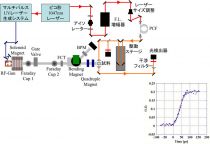Uncovering the Initial Process of Radiation Chemical Reactions: Pulse Radiolysis Experiment

- researcher's name
-
about researcher WASHIO, Masakazu Professor (retired)
- affiliation
- research field
-
Nuclear engineering,Particle/Nuclear/Cosmic ray/Astro physics,Physical chemistry
- keyword
-
background
When high-energy radiation, such as electron beams, is directed towards substances, the substances receive energy from the radiation. This in turn causes reactions in time segments of picosecond to nanosecond, including electrolytic dissociation (ionization) and excited state, and a reaction intermediate is produced. The intermediate produced has properties that absorb light of specific wavelengths. The pulse radiolysis method measures changes in the yield of the intermediate that is produced, based on the changes in the amount of light absorption. This method of directing electron beams, inducing reactions, projecting light (analysis light), and carrying out analyses is called the “pump-probe method.” This is expected to not only lead to the uncovering of the initial process of radiation chemical reactions, but also the development of medical and nuclear energy applications.
summary
The Washio Laboratory is developing the world’s smallest pulse radiolysis system using a compact photocathode RF electron gun. At present, the laboratory has nearly completed the development of a nanosecond resolution system and picosecond resolution system.
The nanosecond system is capable of directly measuring time behavior using an oscilloscope. Thus, many samples may be measured in a short timeframe, and combined with the picosecond system, the phenomenon can be followed in a broad time region.
application/development
This research is expected to contribute not only to uncovering the initial process of radiation chemistry, but also to developing medical and nuclear energy applications.
predominance
With the time resolution of conventional measuring devices, only the time region up to nanosecond could be measured. However, by using electron beams with a time width of picosecond and analysis light, the phenomenon in the picosecond region may be followed, irrespective of the resolution of the measuring device. A hydrated electron absorption measurement experiment was conducted and found that the system has sufficient time resolution and S/N. Time resolution 28ps, S/N 19.9
purpose of providing seeds
Sponsord research, Collaboration research, Technical consultation
remarks
Affiliation: Japanese Society of Radiation Chemistry; The Physical Society of Japan; The Chemical Society of Japan; The Society of Polymer Science, Japan; Atomic Energy Society of Japan; RadTech Japan
material
same researcher's seeds
posted:
2014/05/21





